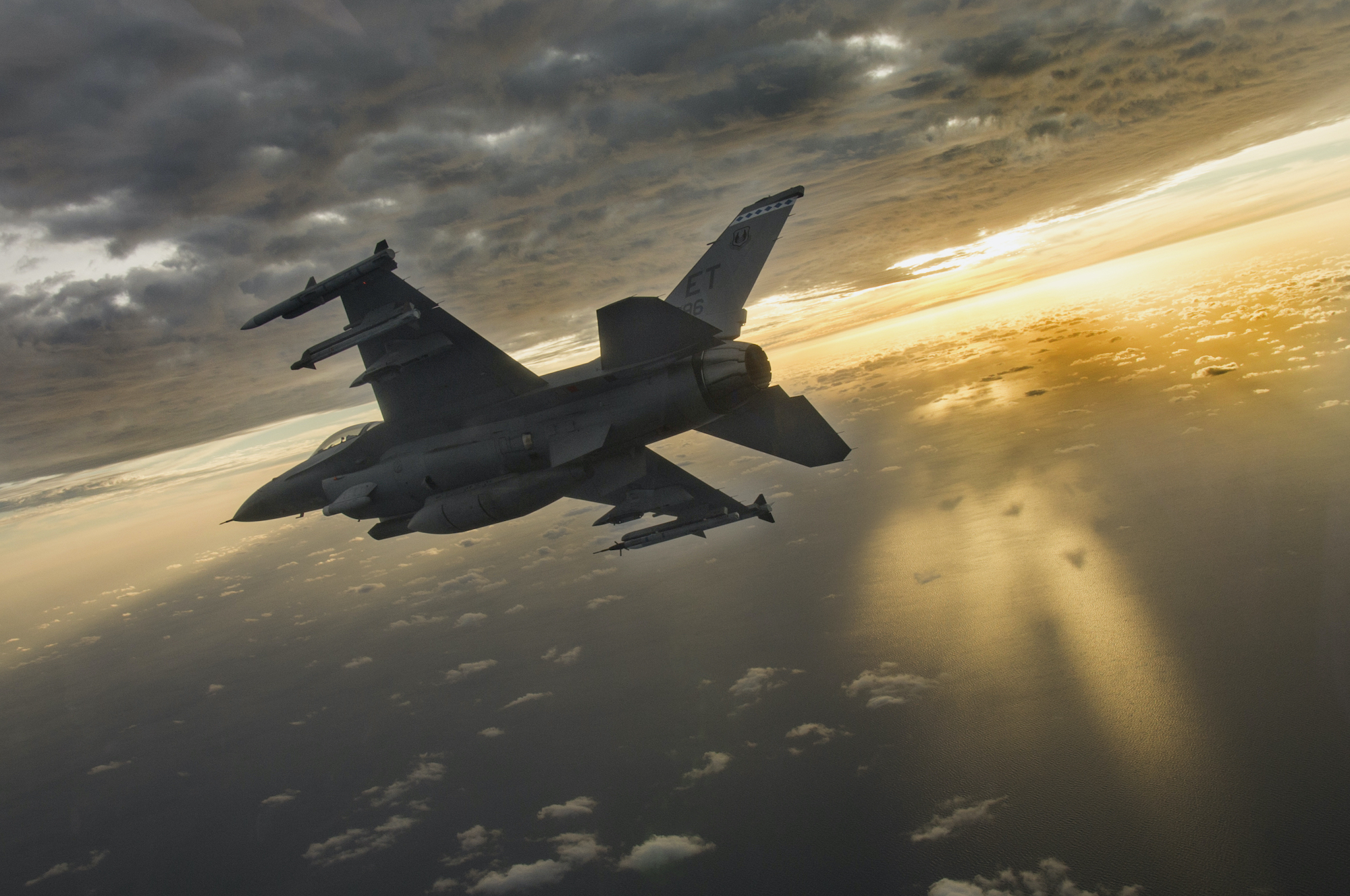

Fighter jets need humans to fly them, but someday, that could change. This week, the Defense Advanced Research Project Agency—better known as DARPA—hosted a virtual Top Gun-style competition in which various artificial intelligence algorithms flew simulated jets in digital dogfights. No actual planes were in the air, but the goal was to see which AI agent could provide the most formidable fighter. The event kicked off on Tuesday morning, and on Thursday, the strongest AI battled against a simulated F-16 operated by a real flesh-and-blood pilot.
The event this week was the third stage in what’s called the AlphaDogfight Trials. The first trial in the series, held last fall, was very much rookie algorithms trying to figure out aviation fundamentals, explains Col. Dan Javorsek, the manager of the event at DARPA and a former F-16 aviator and test pilot. “What you were basically watching was the AI agents learning to fly the plane,” Javorsek says. (His call sign is “Animal,” a reference to the Muppets.) “A lot of them killed themselves on accident—they would fly into the ground, or they would just forget about the bad guy altogether, and just drive off in some direction.” In other words, Maverick or Iceman would probably just laugh at them.
Javorsek compares that stage to NASA’s early days, when rockets kept exploding. “It was not inspiring,” he adds. But early this year, during the second trial, it went better. “We watched the agents go from being able to barely fly the airplane and barely prevent [themselves] from crashing, into true behaviors that looked like dogfighting,” Javorsek says.
Dogfighting may be the colloquial term made famous by the movie Top Gun, but the military refers to that type of engagement as BFM, for Basic Fighter Maneuvers. The AI agents trying to master this practice come from eight different teams, including Goliaths such as Lockheed Martin and Aurora Flight Sciences (part of Boeing), and other smaller or less well-known players, like Georgia Tech Research Institute or Heron Systems.
While this competition happened virtually, companies are already working on the hardware for pilotless fighter jet-type drones in the real world. One such little uncrewed aircraft is called the Valkyrie, or XQ-58A, which is made by California-based company Kratos. Another comes from Boeing, and is a uncrewed fighter jet with a modular nose—it’s dubbed the “Loyal Wingman.” The idea behind these types of machines is that they could be a type of robot wingman, escorting an aircraft flown by a human. Since they’d be less expensive to make than a full-fledged fighter jet and wouldn’t have a human on board, they’d also be attritable: a craft that wouldn’t be devastating to lose in combat.
Javorsek, of DARPA, says that autonomous projects like those are on their radar, but that philosophically, their focus is slightly different. Initiatives outside of DARPA, he says, have “tended to fixate on the Beyond Visual Range (BVR) problem, which is not the first thing we do with our pilots.” Militaries might want to send an uncrewed fighter jet ahead, like a scout, and possibly attack an enemy’s air defenses. But before something like that can happen, Javorsek contends that AI needs to prove that it can carry out a more basic task: the dogfight.
That’s what this week’s competition was all about, in which the different teams flew against algorithms created by the Johns Hopkins Applied Physics Laboratory and each other, too.
Javorsek says that looking into the future, he sees a split between the types of tasks that AI and humans might handle, with algorithms focusing on physically flying an aircraft and people free to keep their minds on the bigger picture. “The vision here is that we get human brains at the right spot,” he reflects. Artificial components can focus on the “low-level, maneuvering, tactical tasks,” he says, while their flesh-and-blood counterparts can be “battle managers” who are able to read “context, intent, and sentiment of the adversary.” (Helicopter-maker Sikorsky, which has been working on an aircraft that’s much easier to fly than a traditional chopper, advocates for a similar configuration.)

While this DARPA competition had the flying happening in digital skies, real-life flight in an actual fighter jet is intensely physically demanding on the aviators on board—something I had the chance to experience firsthand in an F-16. Pulling hard turns or accelerating quickly produces dramatic G forces, and if the pilot and crew don’t manage them correctly, they could pass out. Artificial intelligence might someday fly a plane in combat, but if a pilot were to hypothetically be on board, he or she is going to want to be able to stay conscious throughout the fight. In other words, any algorithm with control of the stick will need to consider what humans can withstand. Or, if the AI is in charge of an uncrewed drone, then it wouldn’t need to worry about the impact of Gs on a person at all.
Update on August 21:
The lead AI algorithm, created by Heron Systems, battled a human pilot who flew a digital F-16 in a virtual reality-style simulator on Thursday. Heron’s agent defeated the human (call sign, Banger) by five to zero. “I think technology has proven over the past 20 years that it’s able to think faster than a human, and react faster, in a precise, pristine environment,” Banger reflected in a conference call with the media after the event.
You can watch the dogfight in the video above—it begins at the 4:40:00 mark.
This article was first published on Wednesday, August 19. It has been updated.

